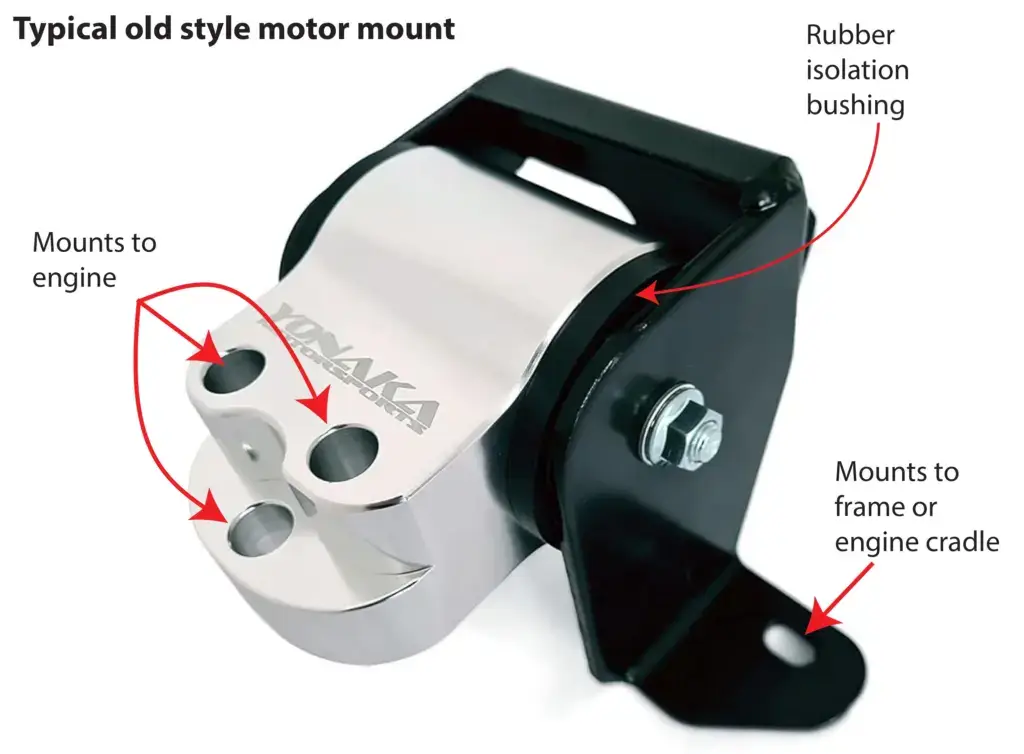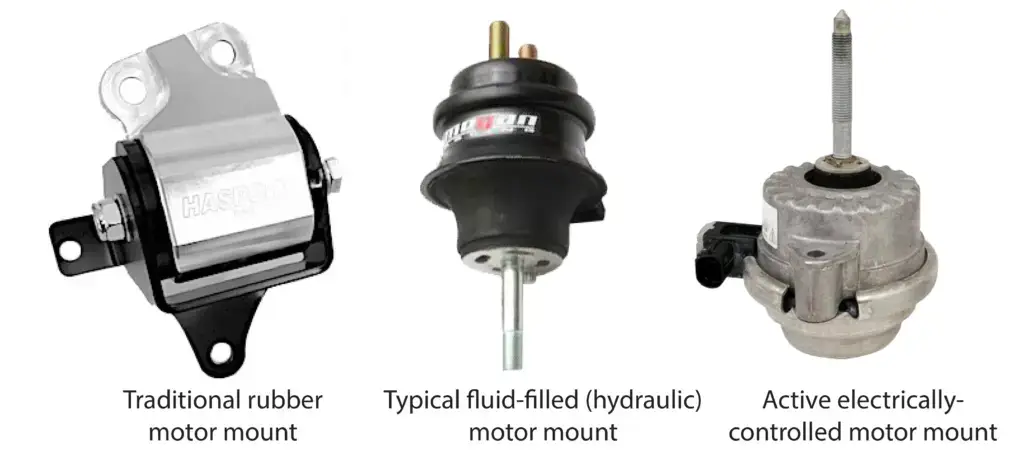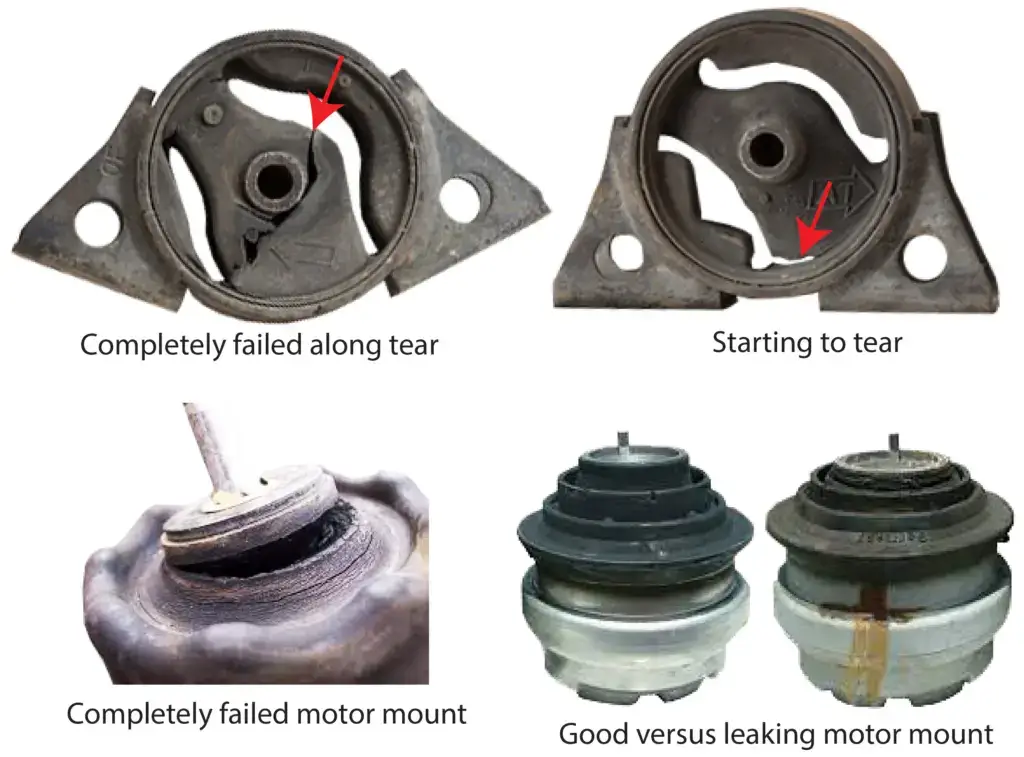How motor mounts work and how they fail
A motor mount limits engine movement and dampens vibration
Motor mounts, also known as engine mounts, play a critical role in securing the engine to the chassis of a vehicle and in reducing engine vibration. There are three types of motor mounts; traditional rubber (elastomeric) mounts include two metal plates bonded to a rubber block or bushing, hydraulic fluid-filled mounts, and active motor mounts that are electrically controlled to reduce engine vibration that’s transmitted to the cabin. Motor mounts also control engine movement. This article will discuss how motor mounts work and how they fail.
How a traditional motor mount works
A traditional style motor mount consists of two mounting plates connected by a molded rubber isolation block or bushing.
this type relies on the softness of the rubber to dampen vibration transfer to the frame or engine cradle while also being hard enough to resist engine movement or twist. Because the rubber must absorb vibrations and resist twisting, there’s always a compromise between the rubber’s hardness versus vibration dampening abilities. If the rubber is too hard, it will transmit more engine vibration to the cabin, causing noise irritation. Carmakers must tune the rubber durometer (hardness) to the engine design and mounting configuration. In fact, the carmaker may use different rubber hardness in each of the motor mounts to compensate for engine twist in one location versus vibrations in another.

How a fluid filled hydraulic motor mount works
As carmakers developed small, more fuel-efficient engines with fewer cylinders, they had to redesign motor mounts to eliminate the additional vibrations created in smaller these 4-cylinder engines. Changing rubber hardness simply didn’t always work. Keenly aware that their vehicles would be compared for ride comfort and reduced noise, carmakers started using fluid -filled hydraulic motor mounts. Here’s how these motor mounts work
The hydraulic motor mount (also referred to as “hydro-mounts”) is filled with a glycol-based fluid, with its viscosity tuned to the engine weight and vibration and torque characteristics. Much like a shock absorber, the mount contains multiple chambers and the fluid flows back and forth between the chambers depending on how much torque (twist) the engine encounters. As the engine moves, the rubber isolation component absorbs some movement. As the movement increases, pressure exerts on the fluid, which opens the valve and fluid flows into the air chamber.
The rubber isolation and fluid movement allows an hydraulic motor mount to absorb more movement and vibration.
How an active motor mount works
To reduce fuel consumption carmakers have developed different cylinder deactivation systems that create even more vibration issues that even hydraulic motor mounts can’t stop.
So carmakers turned to active motor mounts that neutralize vibrations by applying electrically generated compensation movements.
Active motor mounts operate in one of three ways; by vacuum control, electric control, or through magneto rheological control.
What is a vacuum motor mount
In vacuum operated systems, vacuum sucks the air out of the air chamber, causing the mount to work more like a traditional elastomeric mount. As more vibration cancellation is required, the vacuum is stopped and air is pushed back into the mount.
How an electrically operated hydraulic mount works
An electrically operated active mount systems consist of a hydraulic mount with an actuator, an analog acceleration sensor and an electronic control unit (ECU). The acceleration sensor measures the vibrations coming from the engine. Based on that data, the ECU calculates the needed compensation movements of the active mount. It then sends electrical signals to the actuator inside the active hydro mount to cancel out the incoming vibrations.
In normal driving, an active mount functions like a conventional hydraulic mount, dampening vibration through fluid transfer and absorption. However, when cylinder deactivation systems are activated, the active function of the mount comes into play. It can operate the actuator up and down to control the inside pressure of the fluid and then adjust the dynamic stiffness of the mount, enhancing the vibration isolation performance while driving.
What is a Magneto rheological mount
Magneto rheological mounts use a completely different technology to vary the stiffness of the mount. MR technology was developed by Delphi. MR mounts contain a fluid filled with small particles of iron. As the system determine the need for more vibration control, it applies an electric current or magnetic field to the fluid. The current or magnetic field causes the iron particles to line up which increases the viscosity of the fluid. By rapidly varying the electrical current the MR motor mount can rapidly vary its stiffness.
How mounts fail
How rubber mounts fail
• Age causes the rubber to degrade, crack and separate from the metal flanges
• Heat degrades the rubber, also causing cracks and adhesive failure
• Fluid contamination from motor oil and coolant leaks degrade the rubber, causing it to swell and fail
• Excessive torque or cycling. Hard driving with rapid changes in torque can stress the rubber and adhesive, causing the rubber to debond and the mount to fail.
How hydraulic mounts fail
• Rubber degradation due to all of the factors listed above
• Fluid leaks due to rubber degradation, puncture, or extreme driving that exceeds the mounts capabilities
How active and MR mounts fail
• Rubber degradation due to all of the factors listed above
• Fluid leaks due to rubber degradation, puncture, or extreme driving that exceeds the mounts capabilities
• Electrical failures in the actuator, sensor or module
See this post to learn more about symptoms of a bad motor mount
©, 2023 Rick Muscoplat
Posted on by Rick Muscoplat


